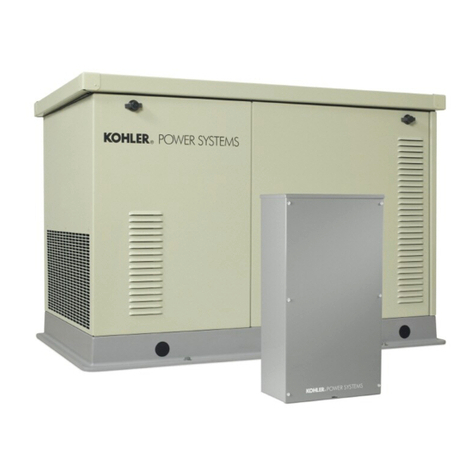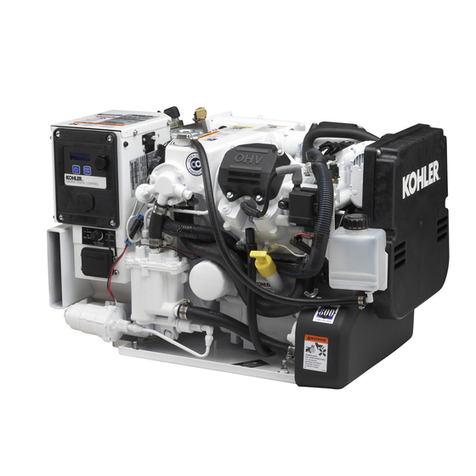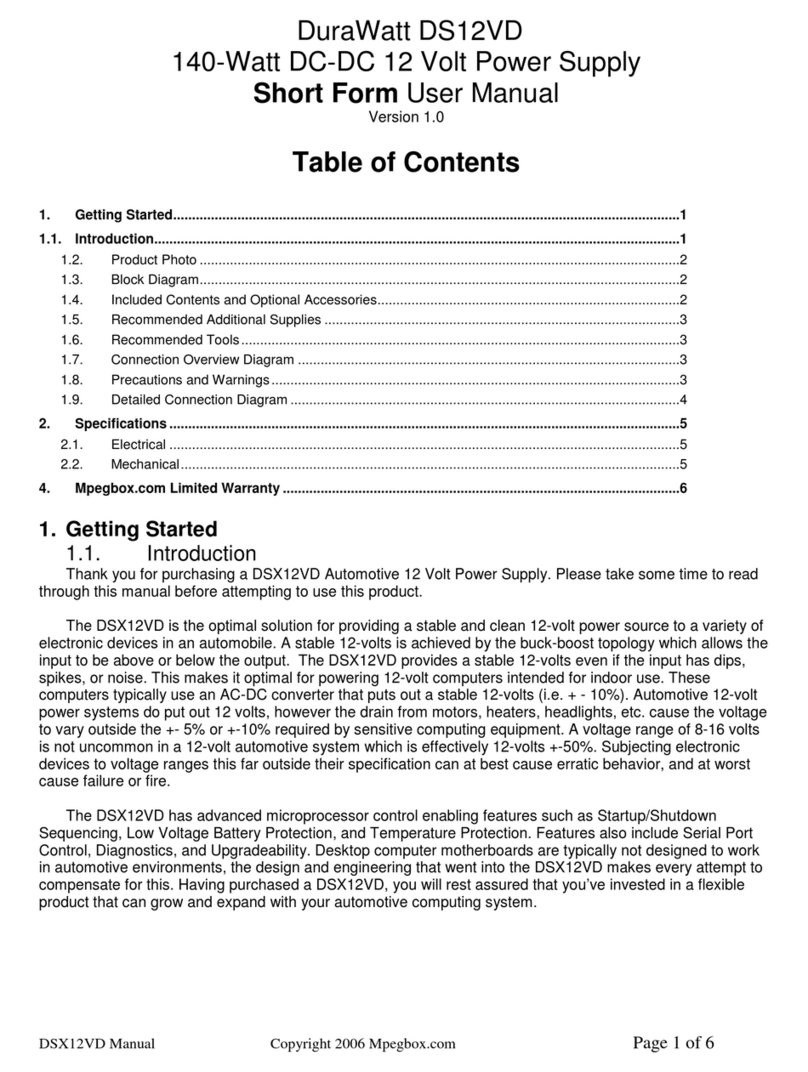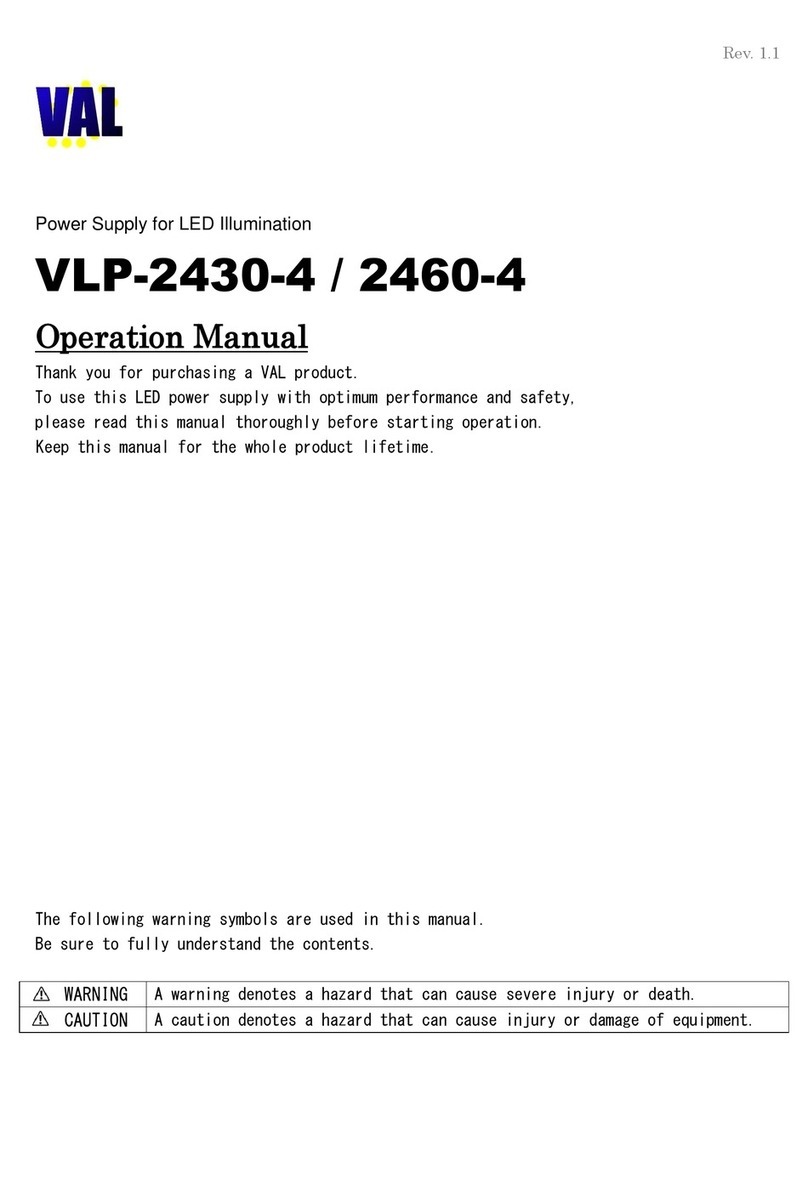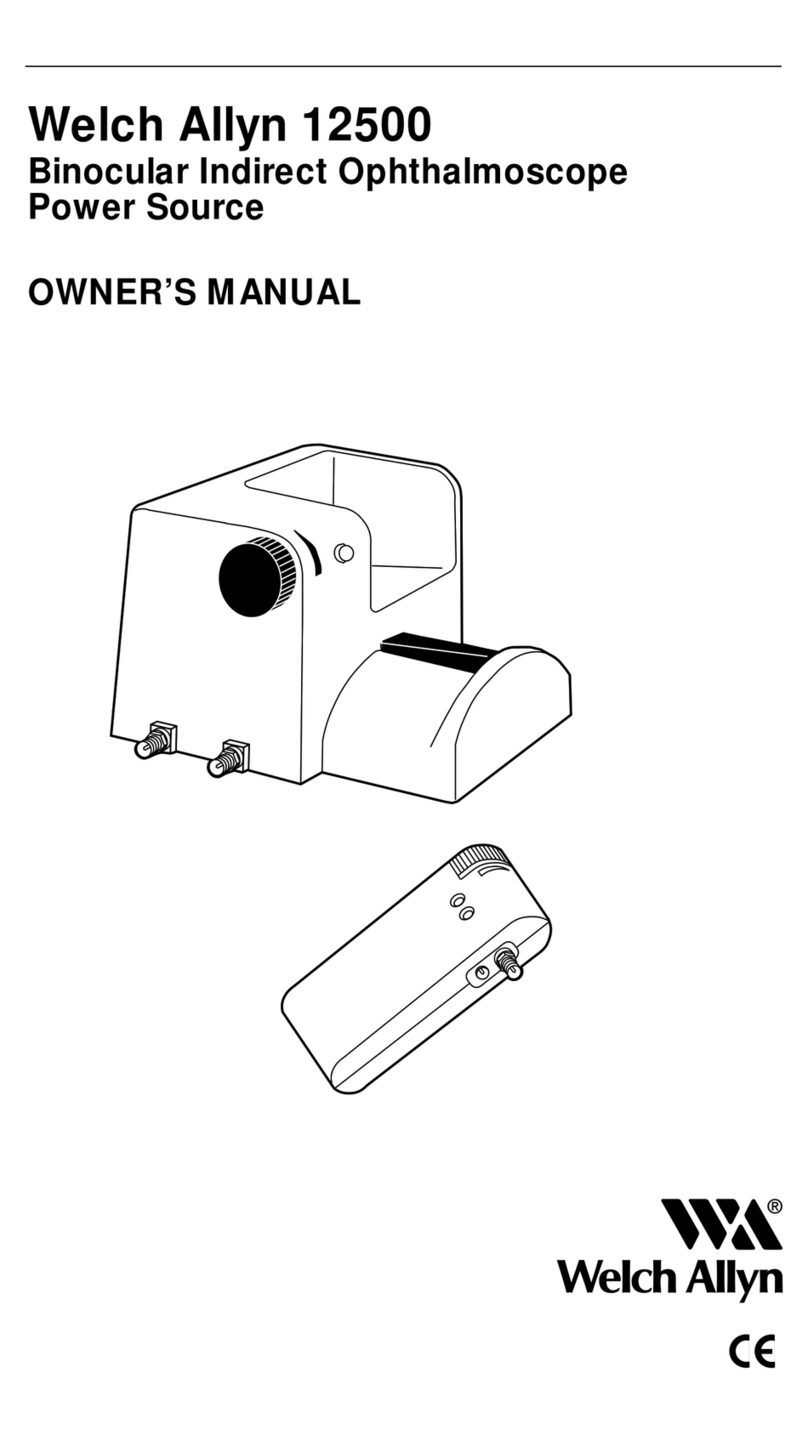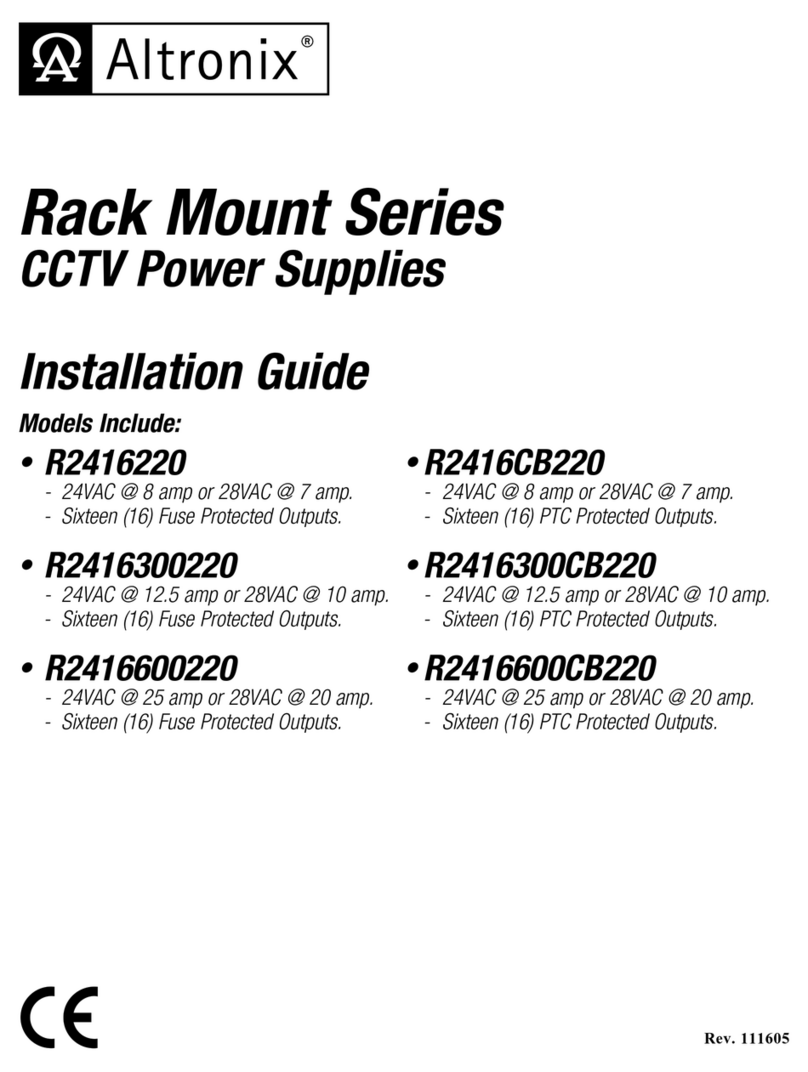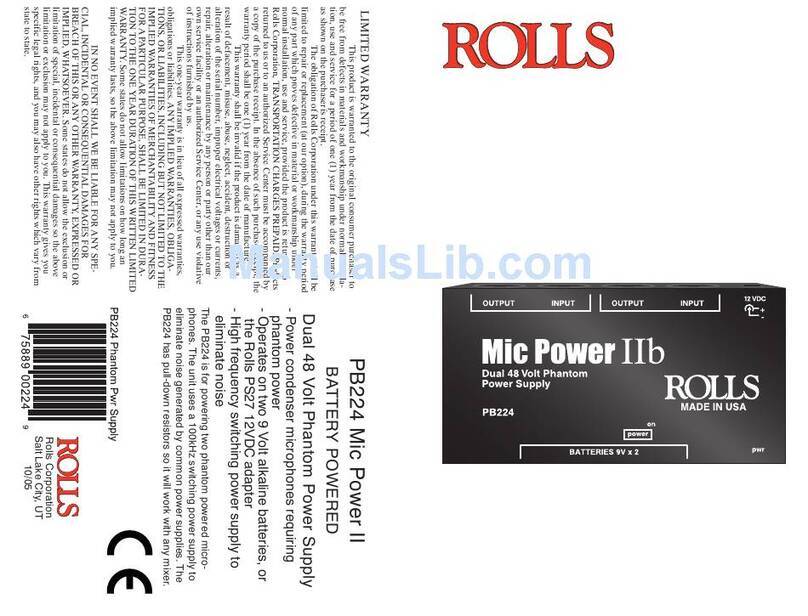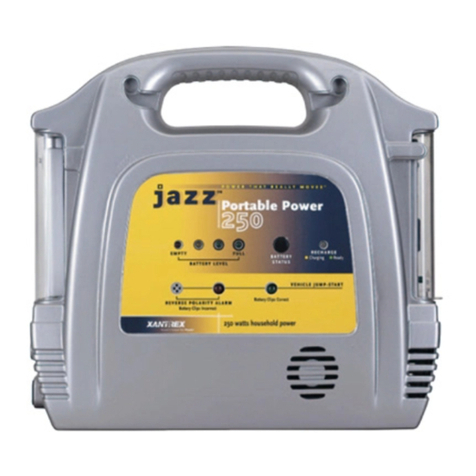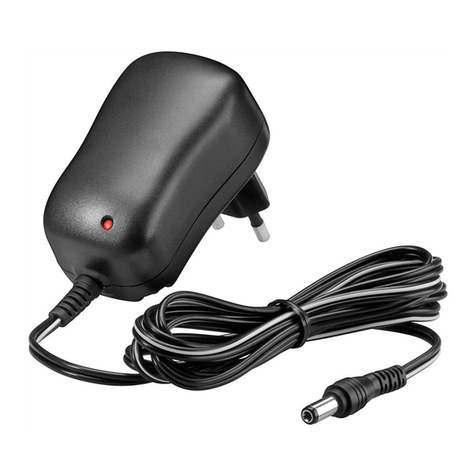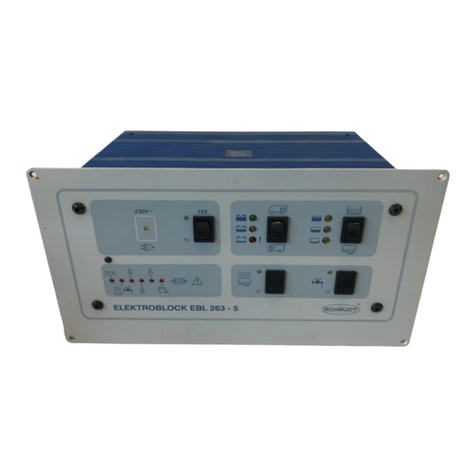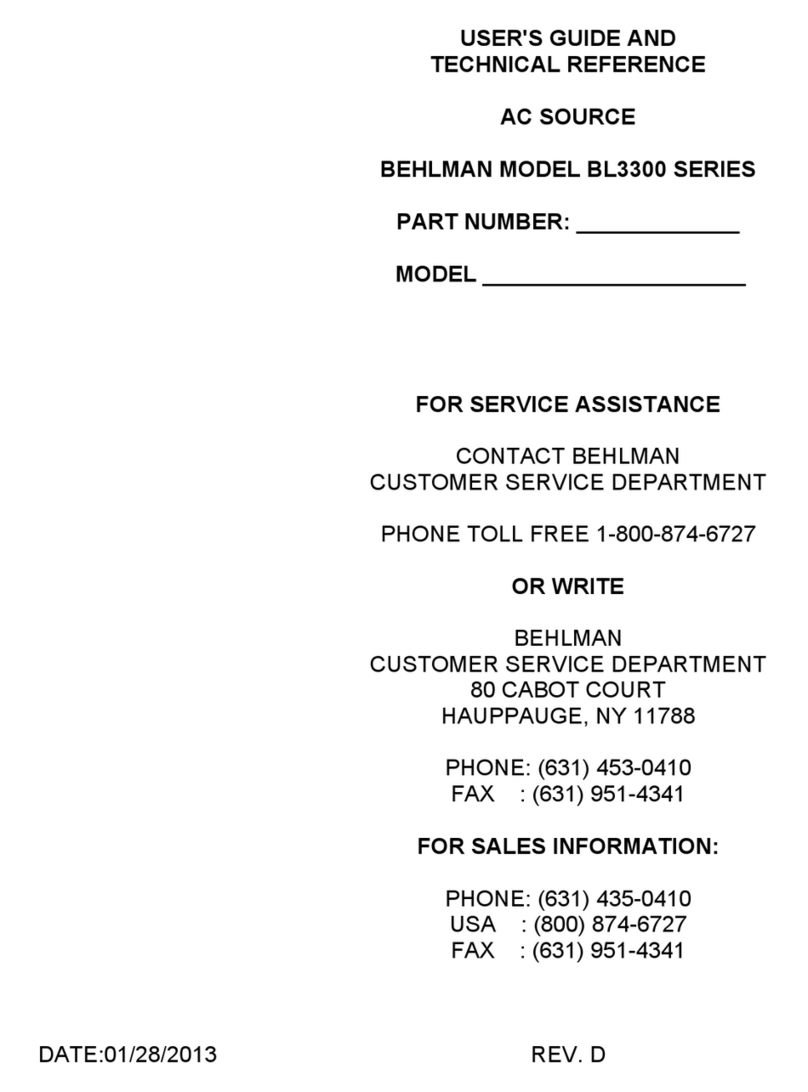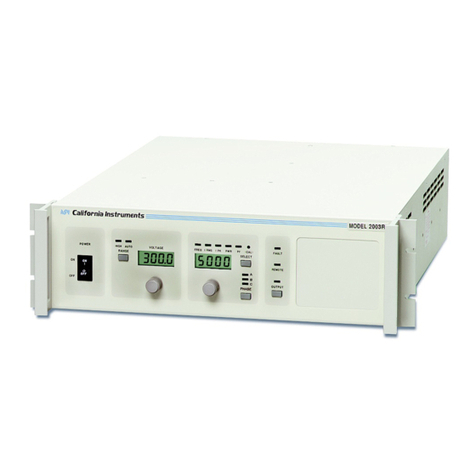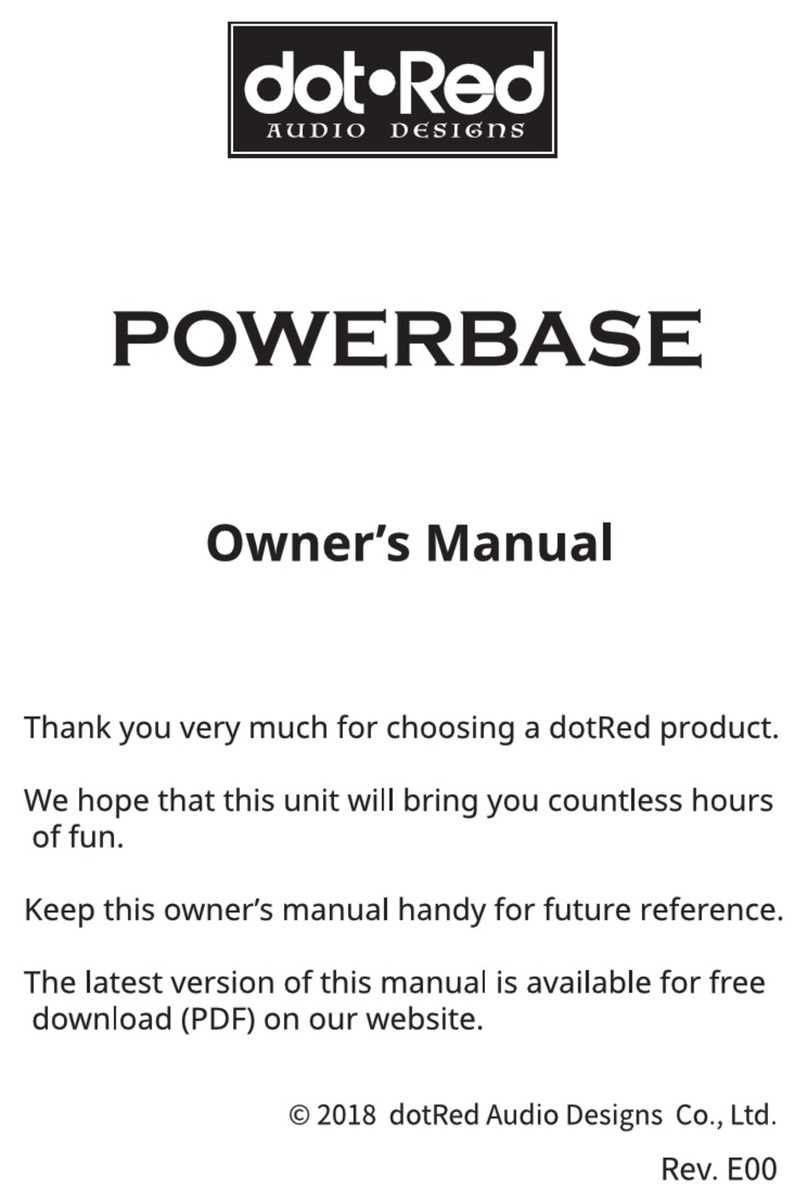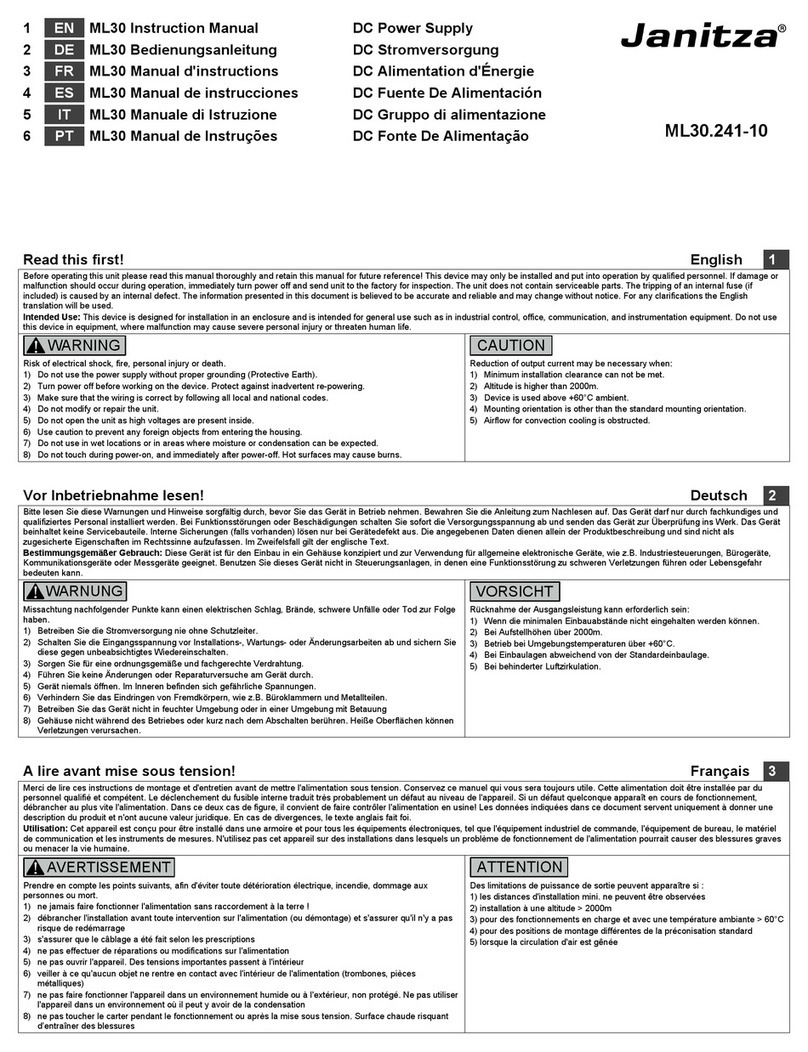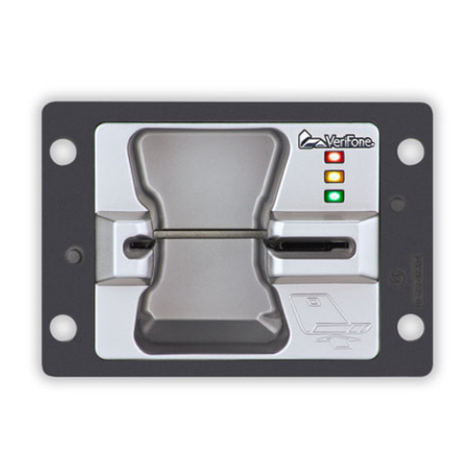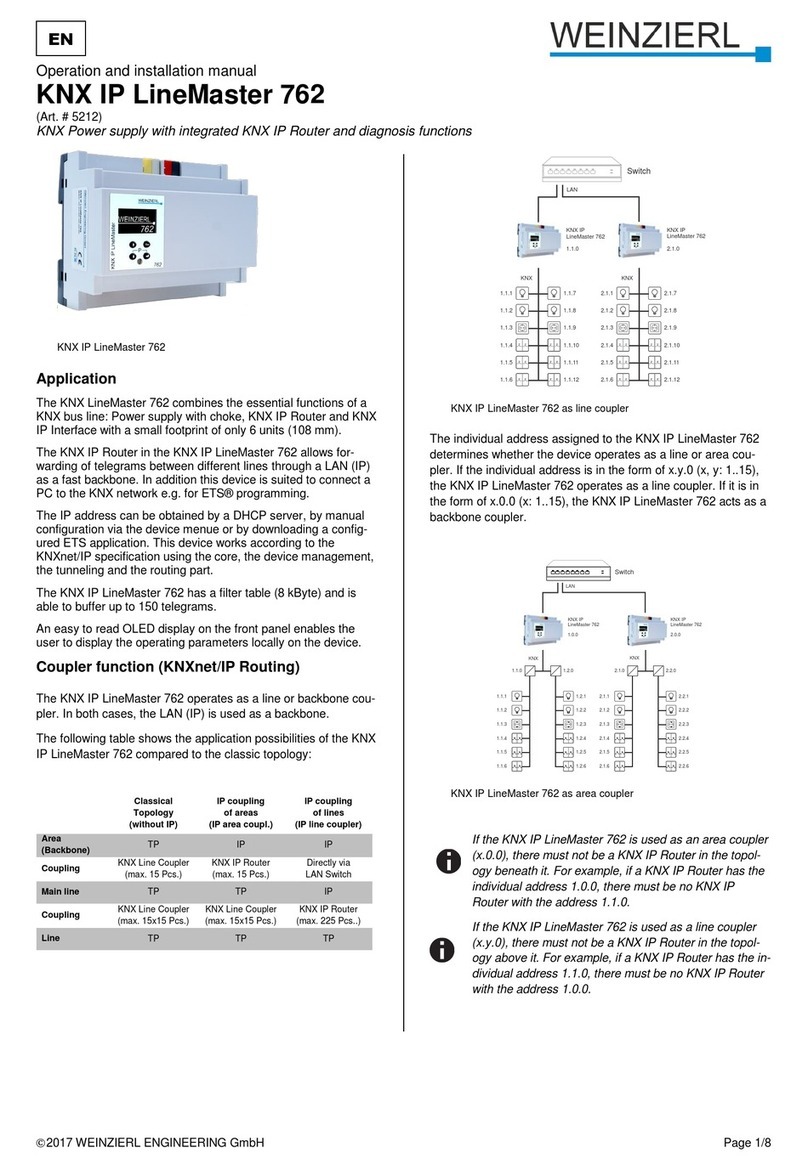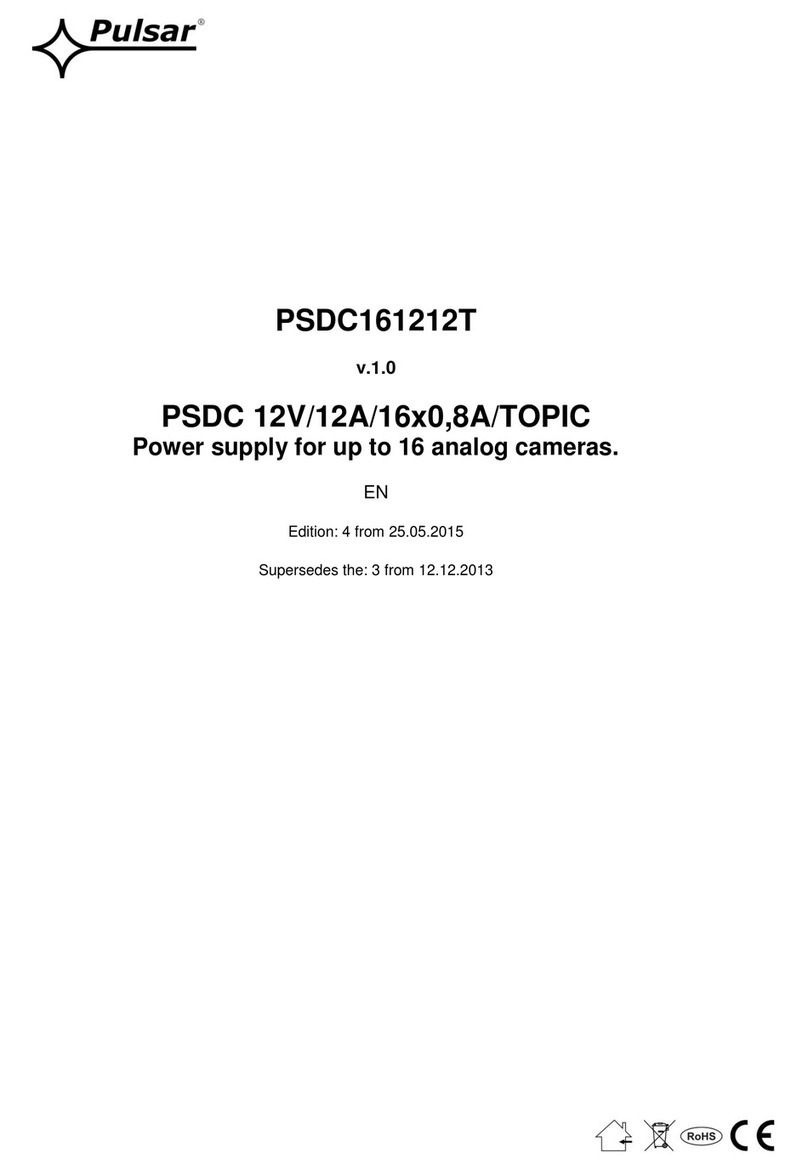Kohler MF1500DPA User manual


TS_627_02 - PowerWAVE MF1500 DPA User Manual 21/4/22

TS_627_02 - PowerWAVE MF1500 DPA User Manual 21/4/22
Document Control
Useful Contacts
All product, product specifications and data are subject to change without notice to improve reliability, function, design or otherwise.
Kohler Uninterruptible Power Ltd. has taken every precaution to produce an accurate, complete and easy to understand specification
document and will assume no responsibility nor liability for direct, indirect or accidental personal or material damage due to any
misinterpretation of, or accidental errors, in this manual.
© 2019 Kohler Uninterruptible Power Ltd.
This manual may not be copied or reproduced without written permission of Kohler Uninterruptible Power Ltd.
ISSUE DATE REVISION SUMMARY
TS_627_01 11/10/2021 Initial issue
TS_627_01 21/04/2022 Maintenance section updated
www.kohler-ups.co.uk Kohler Uninterruptible Power Ltd. web site
ukservice.ups@kohler.com Service department – booking service, fault reporting etc.
uktechnicalsupport.ups@kohler.com Technical queries
uksales.ups@kohler.com Hardware sales
ukservicesales.ups@kohler.com Extended warranty agreements etc

TS_627_02 - PowerWAVE MF1500 DPA User Manual 21/4/22

TS_627_02 - PowerWAVE MF1500 DPA User Manual 21/4/22
Warranty
The PowerWAVE MF1500 DPA UPS is supplied with a limited warranty that the UPS and its component parts are free
from defects in materials and workmanship for a period of one year from the date of original commissioning, or fifteen
months from the date of original delivery, whichever is the sooner. This warranty is the only warranty given and no other
warranty, express or implied, is provided.
This warranty is invalidated if the UPS is used without having first been commissioned by a fully trained and authorised
person. This warranty does not apply to any losses or damages caused by misuse, abuse, negligence, neglect,
unauthorised repair or modification, incorrect installation, inappropriate environment, accident, act of God or inappropriate
application.
If the UPS fails to conform to the above within the warranty period then Kohler Uninterruptible Power Ltd. will, at its sole
option, repair or replace the UPS. All repaired or replaced parts will remain the property of Kohler Uninterruptible Power
Ltd..
As a general policy, Kohler Uninterruptible Power Ltd. does not recommend the use of any of its products in life support
applications where failure or malfunction of the product can be reasonably expected to cause failure of the life support
device or to significantly affect it’s safety or effectiveness. Kohler Uninterruptible Power Ltd. does not recommend the use
of any of its products in direct patient care. Kohler Uninterruptible Power Ltd. will not knowingly sell its products for use in
such applications unless it receives in writing assurances satisfactory to Kohler Uninterruptible Power Ltd. that the risks of
injury or damage have been minimized, the customer assumes all such risks and the liability of Kohler Uninterruptible
Power Ltd. is adequately protected under the circumstances
Extended Warranty
The Standard Warranty may be enhanced by protecting the UPS with an Extended Warranty Agreement (maintenance
contract). An Extended Warranty Agreement enhances the standard warranty by providing:
• Regular preventative maintenance inspections
• Guaranteed speed of response to operational problems
• 24 hour telephone support
• Fully comprehensive (excluding batteries) cover
Contact the Service Support Hotline on 0800 731 3269 (24Hr.) for further details
Additional Service/Maintenance Support
In addition to providing support for the PowerWAVE MF1500 DPA, Kohler Uninterruptible Power Ltd. can provide
maintenance and support of a wide range of different UPS products.
If you are interested in obtaining an extended warranty for your PowerWAVE MF1500 DPA, or require service/
maintenance support for any other UPS you may have, please contact Kohler Uninterruptible Power Ltd. at the following
address.
CAUTION: The UPS system may contain batteries which must be re-charged for a minimum of 24 hours every
six months to prevent deep-discharging. Batteries that have been, for whatever reason, deeply-discharged are
not covered by the warranty.
Kohler Uninterruptible Power Ltd..
Woodgate
Bartley Wood Business Park
Hook
Hampshire
United Kingdom
RG27 9XA
Tel: +44 (0)1256 386701
0800 731 3269 (24Hr.)
Email: ukservicesales.ups@kohler.com

TS_627_02 - PowerWAVE MF1500 DPA User Manual 21/4/22

TS_627_02 - PowerWAVE MF1500 DPA User Manual 21/4/22 I
:
Safety 1
1.1 Description of symbols used in this manual 1
1.2 User precautions 1
1.3 Declaration of Safety conformity and CE marking 2
General Description 3
2.1 Introduction 3
2.2 Model range 4
2.2.1 Cabinet construction 6
2.2.2 System expansion and parallel cabinets 8
2.3 Parallel module operation 9
2.3.1 Parallel control in a single cabinet 9
2.3.2 Control in a parallel-cabinet system 10
2.3.3 ‘Capacity’ v ‘Redundancy’ parallel UPS systems 10
2.4 Functional description of operation 11
2.4.1 PowerWAVE MF1500 DPA module block diagram 11
2.4.2 UPS Module operating modes 13
2.4.3 UPS System operating modes 14
2.4.4 Xtra VFI 15
2.5 Module Control Panel 18
2.5.1 ON/OFF button 18
2.5.2 LED indicators 18
2.5.3 LCD Display 19
2.5.4 Control Buttons 19
2.5.5 Module control panel menu configuration 20
2.6 UPS Communication facilities 21
2.6.1 Communications interface board 22
2.6.2 Parallel interface board 23
2.6.3 High voltage I/O interface 24
System Control Panel 25
3.1 Introduction 25
3.1.1 Display header bar 26
3.2 HOME screen 27
3.2.1 Events 27
3.2.2 Measures 28
3.2.3 Commands 29
3.2.4 UPS Data 29
3.2.5 User 29
3.3 MIMIC screen 30
3.3.1 MIMIC screen indications 31
3.3.2 Metering from the MIMIC screen 33
3.4 XTRA VFI screen(s) 34
3.5 MODULE SELECTION screen 36
Installation Planning 37
4.1 Introduction 37
4.2 Environmental and mechanical planning 37
4.2.1 Environmental considerations 37
4.2.2 Installation clearances 37
4.2.3 Floor fixings 39
4.3 Electrical planning 41
4.3.1 General cabling requirements 41
4.3.2 Power cabling options 45
4.3.3 Battery configuration 48

:
II TS_627_02 - PowerWAVE MF1500 DPA User Manual 21/4/22
4.3.4 Battery cabling 50
4.3.5 Control cables 50
4.3.6 Fuse & cable sizing 51
4.3.7 Input/output supply protection 51
Installation Procedure 52
5.1 Introduction 52
5.2 Taking receipt of the UPS 52
5.2.1 Reporting transportation damage 53
5.2.2 Local transportation 53
5.2.3 Storage 53
5.3 Unpacking 54
5.4 1500 kVA Cabinet installation 56
5.4.1 Cabinet installation kit 56
5.4.2 Joining the cabinets 57
5.4.3 Connecting the busbars 62
5.4.4 Connecting the control cables 63
5.4.5 Final positioning 64
5.4.6 Refit the UPS modules 64
5.5 1000 kVA Cabinet installation 65
5.5.1 Final positioning 65
5.6 Electrical installation 66
5.6.1 Safety notes 66
5.6.2 Power cable connections 66
Operating Instructions 70
6.1 Introduction 70
6.1.1 General warnings 70
6.2 Useful operating notes 70
6.2.1 Module control panel leds 70
6.2.2 External maintenance bypass switch 71
6.2.3 Operating procedure summary 71
6.2.4 Start/stop operating sequence 71
6.3 How to start the UPS system from a fully powered down condition 73
6.3.1 Power-up the load (Maintenance Bypass) 73
6.3.2 Turn on the UPS modules 73
6.3.3 Transfer the load to static bypass 74
6.3.4 Transfer the load to inverter 74
6.4 How to start the UPS system from the maintenance bypass 75
6.4.1 Power up procedure 75
6.5 How to transfer the load from inverter to the maintenance bypass 76
6.5.1 Transfer the load to the UPS static bypass 76
6.5.2 Transfer the load to maintenance bypass 77
6.5.3 Turn off the UPS modules 77
6.6 How to completely shut down the UPS system 78
6.6.1 System shutdown 78
6.7 Operating in ECO mode 79
6.7.1 How to turn on the UPS system and operate in ECO mode 79
6.7.2 How to shut down the UPS system when operating in bypass mode 79
6.7.3 How to manually transfer between bypass mode and inverter mode 79
6.7.4 Load transfer using the system control panel 80
6.8 Individual module stop/start procedure (redundant system only) 81
6.9 Cold start 82
Maintenance 83

TS_627_02 - PowerWAVE MF1500 DPA User Manual 21/4/22 III
:
7.1 Introduction 83
7.2 User responsibilities 83
7.3 Routine maintenance 83
7.4 Battery testing 83
Troubleshooting 84
8.1 Introduction 84
8.1.1 Alarms 84
8.1.2 Events log 84
8.2 Troubleshooting procedure 85
8.3 Troubleshooting table 86
8.4 Contacting service 86
Options 87
9.1 UPS Communications panel 87
9.2 Communications interface 88
9.2.1 Input dry port (X1) 90
9.2.2 Output dry port (X2) 92
9.2.3 Battery temperature sensor (X3) 92
9.2.4 MODBUS Communications bus (X4) 93
9.2.5 CAN BUS Communications bus (X5) 93
9.2.6 Analog input port (X6) 93
9.2.7 Configurable input dry port (X7) 93
9.2.8 Configurable input dry port (X8) 94
9.2.9 +24 Vdc Output port (X9) 94
9.2.10 Configurable output dry port (X10) 94
9.2.11 Configurable output dry port (X11) 95
9.2.12 Serial RS-232 (J1) and USB computer interface 95
9.2.13 Graphical display interface (J3) 95
9.2.14 Status LEDs 95
9.3 High voltage interface board 96
9.3.1 High voltage configurable input dry port (X12) 96
9.3.2 High voltage configurable output dry port (X13) 96
9.3.3 Synchronisation input port (X14) 96
9.4 Parallel interface 97
9.5 Network interface card slots 98
9.6 UPS Monitoring and automated control software 99
9.6.1 The importance of UPS management 99
9.6.2 SNMP monitoring software 99
9.6.3 WAVEMON UPS monitoring and control software 99
9.6.4 PowerREPORTER™ management software 100
Specification 102
10.1 UPS Cabinet general specification 102
10.1.1 1000 kVA/kW Cabinet 102
10.1.2 1500 kVA/kW Cabinet 102
10.2 Electrical characteristics 103
10.3 Battery 104
10.4 Environmental and standards 105

:
IV TS_627_02 - PowerWAVE MF1500 DPA User Manual 21/4/22

TS_627_02 - PowerWAVE MF1500 DPA User Manual 21/4/22 1
1Safety
1.1 Description of symbols used in this manual
1.2 User precautions
WARNING: The warning symbol is used where there is danger of an electrical shock, equipment damage or
personal injury.
CAUTION: The caution symbol is used to highlight important information to avoid possible equipment
malfunction or damage.
WARNING: Keep this manual with the UPS for future reference.
WARNING: The UPS and peripheral equipment must be installed by suitably qualified and trained personnel
who are aware of the potential shock hazards.
WARNING: Do not attempt to install this UPS system until you have read and understood ALL the safety
instructions and hazard warnings contained in this manual.
WARNING: High leakage current!
Ensure that the UPS has been correctly earthed before you connect the mains power supply.
WARNING: Do not apply electrical power (AC or DC) to the UPS system before it has been commissioned by
a Kohler Uninterruptible Power Ltd. approved engineer.
WARNING: Do not attempt to operate the UPS system until it has been fully commissioned and handed over.
The commissioning engineer will provide operator training as part of the commissioning procedure.
WARNING: Do not open or remove the UPS covers. You run a risk of exposure to potentially lethal voltages if
you open or remove the UPS covers! All servicing must be performed by a Kohler Uninterruptible Power Ltd.
approved engineer.
WARNING: When operating this equipment always follow the procedures contained in this User Manual.
Kohler Uninterruptible Power Ltd. will assume no responsibility or liability for accidents or injuries due to
incorrect operation or manipulation of the UPS or peripheral equipment.
CAUTION: The PowerWAVE MF1500 DPA is a Class A UPS product (according to EN 62040-3). In a
domestic environment the UPS may cause radio interference. In such an environment the user may be
required to undertake additional measures.

1: Safety
2TS_627_02 - PowerWAVE MF1500 DPA User Manual 21/4/22
1.3 Declaration of Safety conformity and CE marking
The PowerWAVE MF1500 DPA UPS system is designed and manufactured in accordance with Quality Management
Systems standard ISO 9001 / EN 29001. The CE marking indicates conformity to the EEC Directive by the application of
the following standards in accordance with the specifications of the harmonized standards:
• 2014/35/EC Low voltage directive
• 2014/30/EC Electromagnetic Compatibility directive (EMC)
• 2011/65/EU (incl. 2015/863/EU) R0HS Directive
Standards as reference:
• EN-IEC 62040-1
Uninterruptible power supply (UPS). Part 1-1: General and safety requirements for UPS's used in accessible areas
by end users.
• EN-IEC 60950-1
IT equipment. Safety. Part 1: General requirements
• EN-IEC 62040-2
Uninterruptible power supply (UPS). Part 2: EMC requirements
• EN-IEC 62040-3
Uninterruptible power systems (UPS). Part 3: Performance and test requirements
• 2011/65/EU
Restriction of the use of certain hazardous substances (RoHS) DIRECTIVE
The supplier's responsibility is excluded if the customer modifies, or intervenes with, this product in any way.
Product Standards Standards
Safety EC/EN 62040-1 EC/EN 60950-1
Electromagnetic Compatibility (EMC) IEC/EN 62040-2
Emission cat. C3
Immunity cat. C3
IEC/EN 61000-6-2
IEC/EN 61000-6-4
IEC/EN 61000-4-2
IEC/EN 61000-4-3
IEC/EN 61000-4-5
IEC/EN 61000-4-6
IEC/EN 61000-4-8
Performance Standard EN-IEC 62040-3

TS_627_02 - PowerWAVE MF1500 DPA User Manual 21/4/22 3
2General Description
2.1 Introduction
Congratulations on your purchase of the PowerWAVE MF1500 DPA UPS.
Continuous power availability is essential in today’s dynamic IT and process-related work environments. It is equally
important that any installed power protection system is sufficiently resilient and adaptable to handle changes brought
about by the introduction of new server technologies, migration and centralization.
Such demands are well met by the PowerWAVE MF1500 DPA UPS system, which provides the foundation for continuous
power availability of network-critical infrastructures both in enterprise data centres, where business continuity is of
paramount importance, and in process control environments where manufacturing continuity is essential.
Reliability and quality standards
The PowerWAVE MF1500 DPA UPS incorporates the latest technological developments in power engineering.
Representing a completely new generation of transformerless high power three phase UPS systems, its advanced double
conversion VFI (Voltage and Frequency Independent) topology responds fully to both the highest availability and
environmentally friendly requirements compliant with IEC 62040-3 (VFI-SS-111) standards.
Kohler Uninterruptible Power Ltd. specialises in the installation and maintenance of Uninterruptible Power Systems; and
this powerful UPS is just one example of our wide range of state-of-the-art power protection devices that will provide your
critical equipment with a steady and reliable power supply for many years.
Key features summary
High reliability, upgrade ability, low operating costs and excellent electrical performance are just some of the highlights of
this advanced UPS system. Other key features include:
•Decentralised Parallel Architecture (DPA) – Each UPS module contains its own bypass circuit, which greatly
improves the overall system reliability by removing a common point of failure that is often present in more
traditional UPS systems.
•Unity output power factor (kVA = kW) – Blade server friendly. No de-rating required with leading PF loads.
•Best in class AC-AC efficiency – greater than 97% efficiency for all loads (with Xtra VFI function active) minimises
operational costs (TCO).
•Xtra VFI double conversion mode – A complementary feature which enhances the double conversion efficiency of
the UPS when load power is low compared to total UPS system capacity.
•Low input power factor (0.99 @ 100% load) – Cost savings during installation and the entire life cycle (TCO).
•Ease of operation – A graphical control panel on the distribution frame provides a single point of ‘system level’
control, and also allows the operation of each individual module to be interrogated.
•Flexible battery management – Advanced management of battery charging and preventive failure diagnostics
avoids premature deterioration of battery life.
•Top or bottom cable entry – Allows flexible installation into existing plant infrastructure.
•Very low input current distortion – An input current harmonic distortion of <3.0% @ 100% linear load leads to
savings in generator-set power and installation costs.

2: General Description
4TS_627_02 - PowerWAVE MF1500 DPA User Manual 21/4/22
2.2 Model range
PowerWAVE MF1500 DPA 1000 kW Frame
The 1000 kW cabinet comprises a distribution frame and frames for four UPS modules. The distribution frame can be
positioned on either the left or right of the UPS module frames but must be stipulated when placing an order.
Figure 2.1 PowerWAVE MF1500 DPA 1000 kW Frame
1000 kW Frame 1 Module 2 Modules 3 Modules 4 Modules
System power rating (per cabinet) (kVA/kW) 250 500 750 1000
Maximum cabinet rating 1000 kVA / 1000 kW (up to 4 power modules)
UPS type On-Line, transformerless, Modular, DPA
Parallel capability Up to 4 Frames – 4 MVA / 4 MW
Battery Housed external to the UPS. Dimensions/weight/design
is specific to application
Performance specification VFI-SS-111
System cabinet dimensions (W x D x H) mm 2235 x 1000 x 2000
Weight (without power modules) kg 550
Weight (with power modules) kg 900 1250 1600 1950
UPS cabinet colour RAL 9005 (Black)
Ingress protection IP 20
Cable entry Top or Bottom (To be defined at Order)
Ventilation Front to Top
Service access Front
Installation clearances mm Front 1555 mm, Top 500 mm, Rear 0 mm
Heat dissipation - 1000 kW linear load (W) 35578
Heat dissipation - 500 kW linear load (W) 13426
Heat dissipation - 250 kW linear load (W) 7053
Cooling airflow (m3/h) - EN 62040-1-1 7576
UPS
Module 01
UPS
Module 03
Distribution
Frame
UPS MODULE
SYSTEM
CONTROL
PANEL
CONTROL
PANEL (x4)
Distribution
Frame
UPS MODULE
CONTROL
PANEL (x4)
SYSTEM
CONTROL
PANEL
UPS
Module 02
UPS
Module 04
UPS
Module 01
UPS
Module 03
UPS
Module 02
UPS
Module 04

TS_627_02 - PowerWAVE MF1500 DPA User Manual 21/4/22 5
2: General Description
PowerWAVE MF1500 DPA 1500 kW Frame
The 1500 kW cabinet comprises a distribution frame and frames for six UPS modules. The distribution frame is positioned
in the centre of the cabinet.
Figure 2.2 PowerWAVE MF1500 DPA 1500 kW Frame
1500 kW Frame 1 Module 2 Modules 3 Modules 4 Modules 5 Modules 6 Modules
System power rating (per cabinet) (kVA/kW) 250 500 750 1000 1250 1000
Maximum cabinet rating 1500 kVA / 1500 kW (up to 6 power modules)
UPS type On-Line, transformerless, Modular, DPA
Parallel capability Up to 6 Frames – 6 MVA/4 MW
Battery Housed external to the UPS.
Dimensions/weight/design is specific to application
Performance specification VFI-SS-111
System cabinet dimensions (W x D x H) mm 3045 x 1000 x 2000
Weight (without power modules) kg 845
Weight (with power modules) kg 1195 1545 1895 2245 2595 2945
UPS cabinet colour RAL 9005 (Black)
Ingress protection IP 20
Cable entry Top or Bottom (To be defined at Order)
Ventilation Front to Top
Service access Front
Installation clearances mm Front 1555 mm, Top 500 mm, Rear 0 mm
Heat dissipation - 1500 kW linear load (W) 53367
Heat dissipation - 750 kW linear load (W) 20140
Heat dissipation - 375 kW linear load (W) 10580
Cooling airflow (m3/h) - EN 62040-1-1 11364
UPS
Module 01
UPS
Module 06
Distribution
Frame
UPS MODULE
CONTROL
PANEL (x6)
SYSTEM
CONTROL
PANEL
UPS
Module 02
UPS
Module 03
UPS
Module 04 UPS
Module 05

2: General Description
6TS_627_02 - PowerWAVE MF1500 DPA User Manual 21/4/22
2.2.1 Cabinet construction
Figure 2.3 UPS module insertion
The system input, output and battery power cables are connected to busbars located in the ‘distribution frame’ which then
run across the back of the cabinet to the module frames. The power cables can enter the distribution frame via cover
plates fitted to the top and/or bottom of the frame which can be removed to fit suitable cable glands.
The UPS module is mounted on wheels and it is inserted into (or withdrawn from) the frame with the aid of a portable
‘slider’ which ensures that the module is correctly aligned to the frame. When fitted, the module locked in position by two
shoot-bolts located near the insertion handles and secured to the front of the frame by eight screws.
Note: Figure 2.5 shows the correct positioning of the module slider, with the runners on the slider aligned with the internal
runners on the bottom of the module frame.
The power locking handle located near the bottom of the module engages/disengages the module’s busbar power
connections. The handle is locked into position by a yellow safety bar that must be lifted up to allow the power locking
handle to be moved.
Figure 2.4 shows the power locking handle in the OFF (open) condition. In this state, the module power connectors are
withdrawn into the back of the module and will not therefore connect power to the module.
In Figure 2.5 the handle is in the ON (closed) position, and shows that the power connectors are extended from the back
of the module. In this case the connectors will plug into the busbars running across the back of the module frame to
connect the module to the input mains, battery and UPS output power supplies connected in the distribution frame.
Key Point: When the power locking handle is engaged, the connections are sufficiently tight to prevent the
module from being extracted from the frame.
ALWAYS ensure that the power locking handle is OFF (open) before you attempt to extract the module.
UPS MODULE
MODULE
CONTROL
PANEL
INSERTION
POWER
MODULE
HANDLES
SLIDER
LOCKING
HANDLE

TS_627_02 - PowerWAVE MF1500 DPA User Manual 21/4/22 7
2: General Description
Figure 2.4 Power locking handle OFF (open)
Figure 2.5 Power locking handle ON (closed)

2: General Description
8TS_627_02 - PowerWAVE MF1500 DPA User Manual 21/4/22
2.2.2 System expansion and parallel cabinets
Some UPS applications initially present a low power requirement which increases over time as the application grows. It is
therefore essential that an installed UPS system can be expanded to meet a growing load demand without compromising
the existing load. The Distributed Parallel Architecture (DPA) design of the MF1500 DPA satisfies this requirement with
ease.
An MF1500 DPA system can operate with fewer than the full complement of UPS modules installed. For example, a
6-module (1500 kW) cabinet might initially have only four modules fitted to cater for a load of up to 1000 kW then a fifth,
and sixth, module can be added at a later date to cater for an increased load capacity of up to 1500 kW. In this situation,
the additional module(s) can be installed without needing to shut down the system or transfer the load to the bypass
supply.
This ‘hot-swappable’ design similarly allows a UPS module to be exchanged during system operation without disrupting
the load supply – but of course this depends on the system redundancy and prevailing load demand at the time that the
change is taking place.
For installations where the load demand is greater than 1500 kW, up to four MF1500 DPA cabinets can be connected in
parallel to provide a system capacity of up to 6.0 MW. When two (or more) cabinets are connected together the parallel
communication bus is expanded to include both cabinets, thus the UPS modules within both cabinets effectively operate in
parallel – for example, a system comprising three fully populated MF1500 DPA cabinets will contain 18 fully paralleled
250 kW UPS modules with a system capacity of 4500 kW.
If an existing installation requires an additional MF1500 DPA cabinet to be installed to expand the system, the
existing system will have to be shut down or externally bypassed while the additional cabinet is being electrically
connected.
The system ratings for different MF1500 DPA parallel cabinet combinations are shown in the table below.
Four module cabinet
Six module cabinet
Key Point: It is not necessary to fully populate one cabinet with UPS modules before installing the next cabinet.
For example, if it is known at the planning stage that the eventual system load is likely to reach 4500 KW it
makes good design sense to install and cable-up three MF1500 DPA cabinets and distribute the initial number of
required modules between them, then add further modules as the demand increases.
Parallel cabinet system output (kW) 1 Cab 2 Cab 3 Cab 4 Cab
1 module fitted 250 500 750 1000
2 module fitted 500 1000 1500 2000
3 module fitted 750 1500 2250 3000
4 module fitted 1000 2000 3000 4000
Parallel cabinet system output (kW) 1 Cab 2 Cab 3 Cab 4 Cab
1 module fitted 250 500 750 1000
2 module fitted 500 1000 1500 2000
3 module fitted 750 1500 2250 3000
4 module fitted 1000 2000 3000 4000
5 module fitted 1250 2500 3750 5000
6 module fitted 1500 3000 4500 6000

TS_627_02 - PowerWAVE MF1500 DPA User Manual 21/4/22 9
2: General Description
2.3 Parallel module operation
Figure 2.6 Parallel module operation
2.3.1 Parallel control in a single cabinet
As the power output of all the modules fitted in the UPS cabinet are connected in parallel, an ‘inter-module’ control system
is required to:
• ensure that the UPS modules equally share the load current.
• ensure that the UPS modules are always synchronised to each other – and to the bypass supply (when present).
• synchronise the inverter/bypass load transfer operation such that, for example, if the operator selects ‘bypass
mode’ the static switch in ALL the modules change over in unison.
These inter-module control functions are achieved using an ‘internal parallel control bus’ to pass the necessary control
signals between the UPS control system of each module – this is depicted in Figure 2.6 for a 3-module system.
The parallel control mechanism operates on a master/slave relationship with one module acting as the ‘master’ module
and the remaining modules as ‘slaves.’ If the ‘master’ module is turned off, or shuts down for any reason, the next module
in the chain hierarchy automatically takes over the ‘master’ role. The master/slave hierarchy is set during system
commissioning and the left-most module in the cabinet (module ID P01) is usually designated as the ‘master.’
The internal parallel bus is also connected to the communications interface board in the distribution frame from where it is
interfaced with the system control panel. This allows the system control panel to receive and display data from each
module individually or send a common control signal, such as load transfer commands, to every module simultaneously.
The communications interface board also has the means of interfacing various module/system monitoring and control
functions with a range of external devices – (see "Communications interface," on page 88).
Volt-free
contacts for
remote alarms
panel or BMS
Server (PC)
Interface
Network Mgnt.
Center Interface
Interface Board (CIB)
Communications
(data collection)
UPS Control system
UPS Power
blocks
Battery
Input/output
Supplies
Contactors
Power
Data Interface & Pro
c
e
s
s
o
r
Data I/O
Interface
RS232/485 etc
Network
Card
Dry-port
Outputs
Dry-port
Inputs
UPS Module 1
System
Cont. Panel
UPS Control system
(data collection)
UPS Power
blocks
Battery
Input/output
Supplies
Power
Contactors
UPS Module 2
UPS Control system
(data collection)
UPS Power
blocks
Battery
Input/output
Supplies
Power
Contactors
UPS Module 3
Cabin
e
t
i
n
t
e
r
n
a
l
p
a
r
a
l
l
e
l
b
u
s
TCP/IP RS485 etc

2: General Description
10 TS_627_02 - PowerWAVE MF1500 DPA User Manual 21/4/22
2.3.2 Control in a parallel-cabinet system
Figure 2.7 Parallel cabinet system
A parallel-cabinet system requires the same inter-module parallel control mechanisms as that just described for a single
cabinet installation. This is achieved by breaking into the internal parallel bus in each cabinet and connecting an external
parallel bus, as illustrated in Figure 2.7. A simplified block diagram of the inter-cabinet parallel bus connections is shown in
Figure 9.3 on page 89.
In practice the external parallel bus is implemented by connecting cables to the parallel interface board (PIB) within the
cabinets’ distribution frames in a ring configuration – i.e. the PIB ‘input’ connection in one cabinet is connected to the
‘output’ connection on the PIB in the adjacent cabinet. The ring-bus configuration eliminates a single point of failure. (see
paragraph 9.4 on page 97).
In a parallel-cabinet installation the cabinets are assigned a hierarchical ID in much the same way as the UPS modules
are assigned a master/slave ID. The cabinet that contains the ‘master’ UPS module is normally set as the ‘first’ cabinet.
The illustration in Figure 2.7 shows cabinet 1 as the ‘first’ cabinet and the modules identified as P01 to P12. This is how
the modules are identified on the system control panel – for example to identify a faulty module, or when inspecting a
selected module’s operating parameters. The cabinet and modules’ ID is set be the commissioning engineer.
2.3.3 ‘Capacity’ v ‘Redundancy’ parallel UPS systems
If all the UPS modules connected as a parallel system are required to be operational in order to supply the full system load
it can be described as a ‘capacity’ system. In this type of system if one module is turned off or trips off-line due to a fault
condition then the remaining online modules will be insufficient to continue to supply the load and the load will be
transferred to the bypass supply automatically.
A UPS system that is designed with inbuilt module redundancy contains at least one module more than is necessary to
supply the projected full load. During normal operation all the modules will be turned on and equally share the load
current, but if one module should fail the remaining online modules are capable of maintaining the full load supply and the
system will continue to provide uninterrupted load power. A redundant module system is often described as operating as
an (N+x), where x equates to the number of redundant modules – e.g. an (N+1) system has a module redundancy of 1.
In practice, a system's redundancy measure is entirely load dependent rather than being a pre-programmed number. For
example; an MF1500 DPA cabinet that is fully populated with 6 UPS modules would present a capacity system for a load
between 1250 kW and 1500 kW whereas it would operate as an (N+1) redundant system for loads between 1000 kW and
1250 kW. Below 1250 kW it would present (N+2) system... and so on.
Clearly, the ability to lose one (or more) UPS module yet still supply the rated load with processed, backed-up power
significantly increases the overall system reliability; therefore it is common practice to plan inbuilt module redundancy for
modern-day UPS installations.
External parallel interface bus (ring connection)
Cabinet 1 [First] Cabinet 3
Cabinet 2
P01 P02 P04P03 P05 P06 P08P07 P09 P10 P12P11
Table of contents
Other Kohler Power Supply manuals

